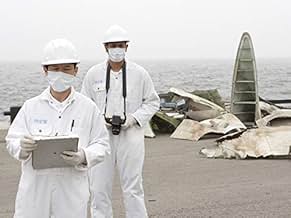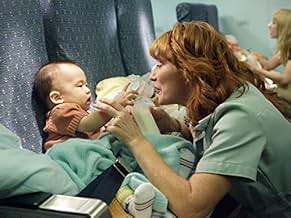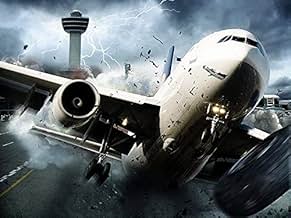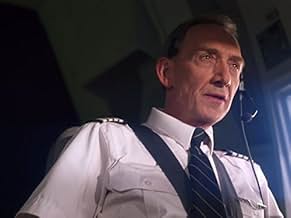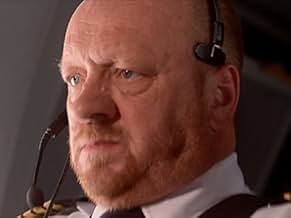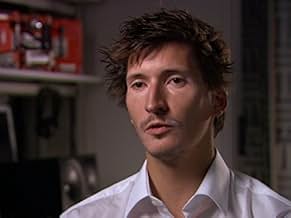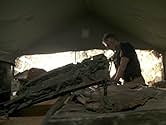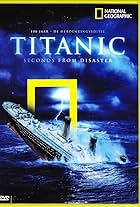Dramatized reconstruction of real-life air disasters, along with interviews with aviation experts and eyewitnesses.Dramatized reconstruction of real-life air disasters, along with interviews with aviation experts and eyewitnesses.Dramatized reconstruction of real-life air disasters, along with interviews with aviation experts and eyewitnesses.
- Awards
- 3 wins & 6 nominations total
Browse episodes
Featured reviews
Just stumbled onto this recently (in its 10th season), on Smithsonian. Fortunately, they show previous season episodes each week, so it's possible to catch up. Also, FYI, Amazon has all of the seasons (not part of Prime).
These are reenactments, with actors. HOWEVER, on many episodes, where the original personnel are available (e.g. passengers, pilots, from survivable accidents), they are interviewed, throughout the reenactment, i.e. interweaving the interviews with the reenactment. Occasionally, when no real flight information is available, some speculative dialog or actions (extrapolations) may be depicted, but most episodes are scripted with actions and dialog from both the Flight Data Recorder and Cockpit Voice Recorder information, in an attempt to meticulously recreate each incident. And, each episode typically includes interviews with the numerous accident investigation team members from the subsequent investigation (except for super-old accidents, where those personnel are now deceased).
As someone else has mentioned, it's not like a "high-budget film", but they do use reasonable CGI, and what appear to often be aircraft simulators, to depict interior and exterior content that is quite believable.
If you have ever asked the question "why do planes crash?", this series is for you. Again, if you fly a lot, and prefer to "not know" (i.e. "ignorance is bliss"), or if true stories, which are inherently horrific, due to the loss of life, are more than you can stomach, then this is definitely not for you. To be clear, they definitely do NOT show real pictures of crash victims, but they do occasionally show real pictures of wreckage, and sometimes depict crash scenes with actors, especially when showing recreations of rescues. Certainly, there is no avoiding thinking about the horror implied by these incidents, when you see the airframe carnage in some of those pictures/scenes, even when they are simply recreations.
The episodes typically depict a (condensed) version of the resulting investigation, as they uncover individual facts and leads, allowing them to eventually understand all of the factors that lead to the accident. It might seem that they are sometimes injecting a bit of drama/tension in into the program, but I always remind myself, that they are often condensing a year-long investigation, plus in-flight reenactments, into a 40-ish minute program, and I think it's a minor miracle to pull that off, and I tend to cut the showrunners some slack, for their efforts.
I would be remiss to not mention that lessons learned from many of these accidents are VERY applicable to non-aviation settings. In any field where lives (or monetary considerations) are a factor, and where "proper training", and/or failure to properly use/follow processes and procedures, could result in "bad things happening", there are important lessons that can be learned, here. It is truly depressing, just how many of these deadly accidents come back to improper training, failure to simply "follow a checklist", or even just deciding to "not fill out some form", because it seems like a waste of time.
I would also be remiss to not stress, once again, that some of these incidents are disturbing, especially for regular travelers. There are incidents depicted here, which have occurred on (supposed) top notch airlines, where things that "should never happen", amazingly do. Cockpit crew members who appear to have never learned basic flying skills (for example, how to recover from a stall, which is something that private aircraft pilots typically learn in the first few hours of flight training), and "maintenance procedural nonsense" that has resulted in the loss of an entire aircraft, and everyone onboard. Again, if you can't handle knowing the truth, then some of these investigations will keep you awake at night.
On the flip side of that, there are some stories of amazing piloting efforts, where flight crews have done just the opposite, and saved part, or all, of their passengers and crew by applying team work, flying skills, and simply being unwilling to give up, right to the very last second.
So, this is a great series, for many reasons. It is almost a 10 out of 10 for me, but as have some other reviewers, I decided on a 9 (which might be unfair, again, considering how much they do with the time allotted).
These are reenactments, with actors. HOWEVER, on many episodes, where the original personnel are available (e.g. passengers, pilots, from survivable accidents), they are interviewed, throughout the reenactment, i.e. interweaving the interviews with the reenactment. Occasionally, when no real flight information is available, some speculative dialog or actions (extrapolations) may be depicted, but most episodes are scripted with actions and dialog from both the Flight Data Recorder and Cockpit Voice Recorder information, in an attempt to meticulously recreate each incident. And, each episode typically includes interviews with the numerous accident investigation team members from the subsequent investigation (except for super-old accidents, where those personnel are now deceased).
As someone else has mentioned, it's not like a "high-budget film", but they do use reasonable CGI, and what appear to often be aircraft simulators, to depict interior and exterior content that is quite believable.
If you have ever asked the question "why do planes crash?", this series is for you. Again, if you fly a lot, and prefer to "not know" (i.e. "ignorance is bliss"), or if true stories, which are inherently horrific, due to the loss of life, are more than you can stomach, then this is definitely not for you. To be clear, they definitely do NOT show real pictures of crash victims, but they do occasionally show real pictures of wreckage, and sometimes depict crash scenes with actors, especially when showing recreations of rescues. Certainly, there is no avoiding thinking about the horror implied by these incidents, when you see the airframe carnage in some of those pictures/scenes, even when they are simply recreations.
The episodes typically depict a (condensed) version of the resulting investigation, as they uncover individual facts and leads, allowing them to eventually understand all of the factors that lead to the accident. It might seem that they are sometimes injecting a bit of drama/tension in into the program, but I always remind myself, that they are often condensing a year-long investigation, plus in-flight reenactments, into a 40-ish minute program, and I think it's a minor miracle to pull that off, and I tend to cut the showrunners some slack, for their efforts.
I would be remiss to not mention that lessons learned from many of these accidents are VERY applicable to non-aviation settings. In any field where lives (or monetary considerations) are a factor, and where "proper training", and/or failure to properly use/follow processes and procedures, could result in "bad things happening", there are important lessons that can be learned, here. It is truly depressing, just how many of these deadly accidents come back to improper training, failure to simply "follow a checklist", or even just deciding to "not fill out some form", because it seems like a waste of time.
I would also be remiss to not stress, once again, that some of these incidents are disturbing, especially for regular travelers. There are incidents depicted here, which have occurred on (supposed) top notch airlines, where things that "should never happen", amazingly do. Cockpit crew members who appear to have never learned basic flying skills (for example, how to recover from a stall, which is something that private aircraft pilots typically learn in the first few hours of flight training), and "maintenance procedural nonsense" that has resulted in the loss of an entire aircraft, and everyone onboard. Again, if you can't handle knowing the truth, then some of these investigations will keep you awake at night.
On the flip side of that, there are some stories of amazing piloting efforts, where flight crews have done just the opposite, and saved part, or all, of their passengers and crew by applying team work, flying skills, and simply being unwilling to give up, right to the very last second.
So, this is a great series, for many reasons. It is almost a 10 out of 10 for me, but as have some other reviewers, I decided on a 9 (which might be unfair, again, considering how much they do with the time allotted).
I like this series. Being a pilot, I'm aware of when an aviation related program is nonsense or not, and most of the facts presented in this program are fairly accurate. It's a relief that it isn't all nonsense.
The facts seem to be presented in such a way that the average non-pilot can understand what happened.
Seeing this program makes you want to stay home and not travel, although statistically speaking, if one must travel, air travel is the safest way to go, with the exception (in North America) of the train.
One episode you'll want to avoid is 'Blow Out', unless you want a headache. It's an hour of mostly camera shaking, when it is unwarranted.
The facts seem to be presented in such a way that the average non-pilot can understand what happened.
Seeing this program makes you want to stay home and not travel, although statistically speaking, if one must travel, air travel is the safest way to go, with the exception (in North America) of the train.
One episode you'll want to avoid is 'Blow Out', unless you want a headache. It's an hour of mostly camera shaking, when it is unwarranted.
I didn't get to see any of the episodes of this great show when it was in it's first run. The episodes I've seen were all in rerun on the National Geographic Channel. This is an amazing well done show. There aren't any well know stars in any of these episodes but the subject matter is so compelling that's a big part of the success. In the cases where there were survivors those people have inserts into the story to elaborate on the telling of the story. These shows are very gripping; you get drawn right into these stories. You find yourself pulling for people literally praying that their character will survive what ever is going to happen. I hope National Geographic will run this who series again on NAT GEO. It's high caliber entertainment.
Most of us have flown, and have heard of those horrible airplane crashes that used to make big splashy news' headlines. They don't happen quite as often as they used to, and in our day and age of information overload, they tend to get drowned out with all the other news around the world. But, they still occasionally occur, and still draw attention.
This show, "Air Crash Investigations", "May Day", or "Air Emergency", or whatever you want to call it, delves deep into the causes and effects of many a famous air liner disaster. And, amazingly enough, despite the theatrics in the recreations, educates the viewer as to the realities of air craft functions and procedures of operation. By the end of the episode you'll feel like an aerospace engineering expert.
The format of the episodes follow a presentation of the event in brief, then an elongated version showing the developments to the event, followed by investigation and analysis. Nearly every episode has an act four that tells of the aftermath's, good and bad, of the disaster or crash that was investigated. All the while you, the viewer, are given great insight into the short comings of procedure, design or environment--more often than not it will be a combination of these factors that will lead to the inevitable; a crash of some form.
Not every episode deals with a crash landing. Sometimes the crew is able to salvage mortal failure on part of the plane, and bring things to a safe end--or, more often than not, a relative safe end. Even when the pilots can bring back a wounded bird so the show still looks into what forced the pilots into that situation, and how the event culminated in its eventful end.
One of the amazing things about this show is that the engineering aspects are explained such that any lay person, anyone who doesn't have any kind of engineering nor scientific background, are brought up to speed on the mechanics and science behind aircraft design so that they can understand, for the duration of the episode, the engineering aspects that were involved. Similarly procedures are explained as to how jets are flown, how they are berthed, how they land, takeoff, and are maintained. Interviews with key players, witnesses, experts in the field, make clear along with charts, animations and recreations provide visual cues to further explain and educate.
As a casual viewer who's flown, but flies no more, I have a curiosity about some crashes here in the United States. The series explored and explained them. I also had a curiosity about the reputation of the DC- 10 during the 70s, and the series looked into that aircraft in a series of episodes as well. All the major crashes are examined; from the bombing of Pan Am over Lockerbie Scotland, to PSA Flight 182 in San Diego, to the more contemporary events such as British Airways flight 38 in Heathrowe.
If this series has a shortcoming it's not that it caters to sensationalism (it uses that as a hook, but this is not the focus of the series), it's the actors in the recreations. It's a double edged sword with the performances because the actors needed to convey the emotional atmosphere of the participants involved, and therefore by necessity ham up the effort. It makes for an unusual viewing experience, but again gives the viewer a concept of the events and the actions of the people involved.
Well, just as car wrecks create rubber-neckers, so it is that I found this show addicting. Again, in spite of its sensationalist promotion, it is an actual documentary with elements of recreated drama interspersed between interviews and explanations. Married to it is a kind of tension that holds the show together and keeps the viewer riveted. You already know what happens, but the show is going to show you why it happened, and, hopefully, what solutions resulted from these horrible events.
It's not a show for the squeamish nor emotional. You might find yourself tearing up, being shocked, maybe outraged, but not very often will you feel settled after viewing this show.
I do recommend it, but definitely watch at your risk.
This show, "Air Crash Investigations", "May Day", or "Air Emergency", or whatever you want to call it, delves deep into the causes and effects of many a famous air liner disaster. And, amazingly enough, despite the theatrics in the recreations, educates the viewer as to the realities of air craft functions and procedures of operation. By the end of the episode you'll feel like an aerospace engineering expert.
The format of the episodes follow a presentation of the event in brief, then an elongated version showing the developments to the event, followed by investigation and analysis. Nearly every episode has an act four that tells of the aftermath's, good and bad, of the disaster or crash that was investigated. All the while you, the viewer, are given great insight into the short comings of procedure, design or environment--more often than not it will be a combination of these factors that will lead to the inevitable; a crash of some form.
Not every episode deals with a crash landing. Sometimes the crew is able to salvage mortal failure on part of the plane, and bring things to a safe end--or, more often than not, a relative safe end. Even when the pilots can bring back a wounded bird so the show still looks into what forced the pilots into that situation, and how the event culminated in its eventful end.
One of the amazing things about this show is that the engineering aspects are explained such that any lay person, anyone who doesn't have any kind of engineering nor scientific background, are brought up to speed on the mechanics and science behind aircraft design so that they can understand, for the duration of the episode, the engineering aspects that were involved. Similarly procedures are explained as to how jets are flown, how they are berthed, how they land, takeoff, and are maintained. Interviews with key players, witnesses, experts in the field, make clear along with charts, animations and recreations provide visual cues to further explain and educate.
As a casual viewer who's flown, but flies no more, I have a curiosity about some crashes here in the United States. The series explored and explained them. I also had a curiosity about the reputation of the DC- 10 during the 70s, and the series looked into that aircraft in a series of episodes as well. All the major crashes are examined; from the bombing of Pan Am over Lockerbie Scotland, to PSA Flight 182 in San Diego, to the more contemporary events such as British Airways flight 38 in Heathrowe.
If this series has a shortcoming it's not that it caters to sensationalism (it uses that as a hook, but this is not the focus of the series), it's the actors in the recreations. It's a double edged sword with the performances because the actors needed to convey the emotional atmosphere of the participants involved, and therefore by necessity ham up the effort. It makes for an unusual viewing experience, but again gives the viewer a concept of the events and the actions of the people involved.
Well, just as car wrecks create rubber-neckers, so it is that I found this show addicting. Again, in spite of its sensationalist promotion, it is an actual documentary with elements of recreated drama interspersed between interviews and explanations. Married to it is a kind of tension that holds the show together and keeps the viewer riveted. You already know what happens, but the show is going to show you why it happened, and, hopefully, what solutions resulted from these horrible events.
It's not a show for the squeamish nor emotional. You might find yourself tearing up, being shocked, maybe outraged, but not very often will you feel settled after viewing this show.
I do recommend it, but definitely watch at your risk.
16 March 2015. With so many mystery thrillers out there along with reality television, it becomes pretty crowded and nauseating to watch it all. But here comes a docudrama that is firmly rooted in re-creations based on authentic presentation and in doing so, makes this television series among the most engaging and thrilling that the medium of film can offer out there. Each episodes contains documentary like precision with the reenactments carefully following dialogue that captures the reality of the moment making each episode vicariously compelling. The storyline is well explained and executed, the human element well presented along with an emotional connection, and the scientific road to discovery all make this CSI-like experience all the more intriguingly better than fiction. Highly rated for its appealing performances and substantive content that pulls the audience directly into the storm.
Storyline
Did you know
- TriviaThis show is known as Air Disasters in the USA and Mayday in Canada but is called Air Crash Investigation in Australia and parts of Europe. The Narrators are different in the various versions.
- Alternate versionsThe French-Canadian version, "Danger dans les airs", features actor (and weekend bush pilot) Gaston Lepage as the narrator, but also as the host, appearing on screen before and after the film, and before commercial breaks.
- ConnectionsFeatured in Screenwipe: Episode #1.3 (2006)
- How many seasons does Air Crash Investigation have?Powered by Alexa
Details
Contribute to this page
Suggest an edit or add missing content



